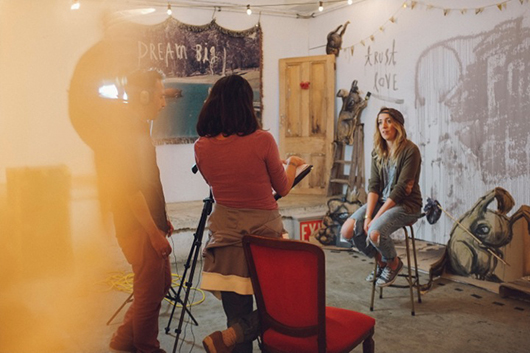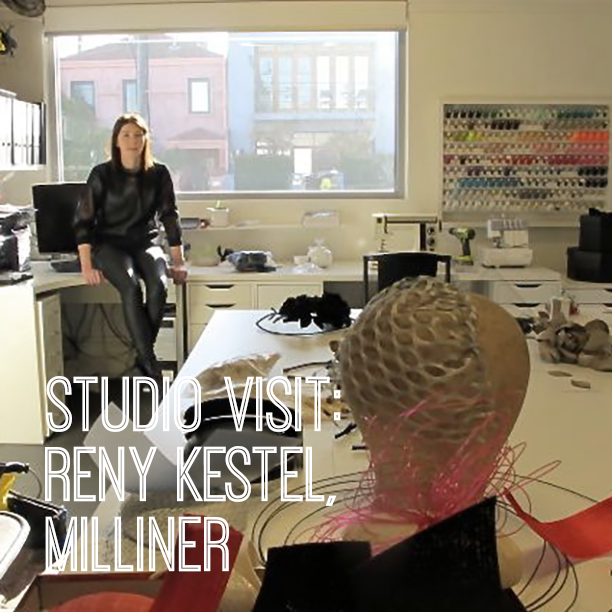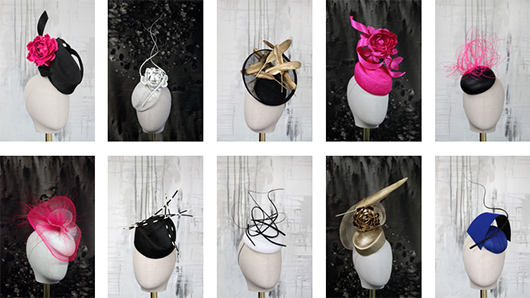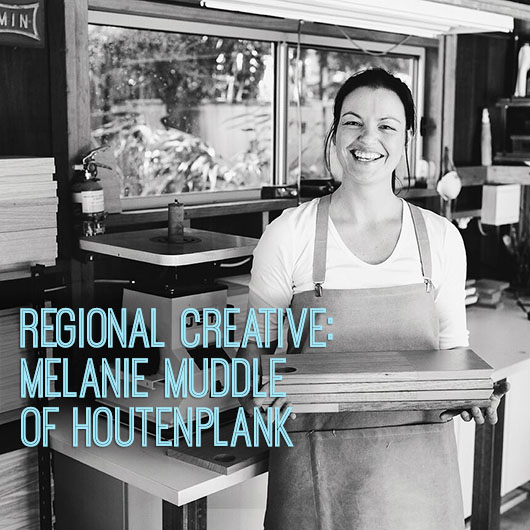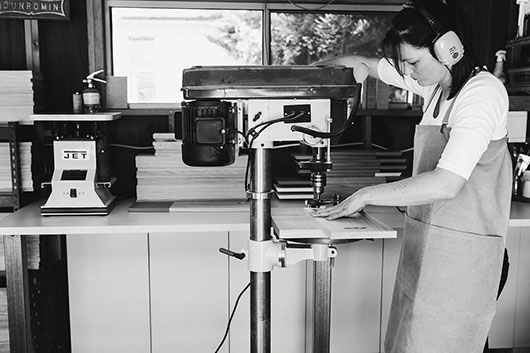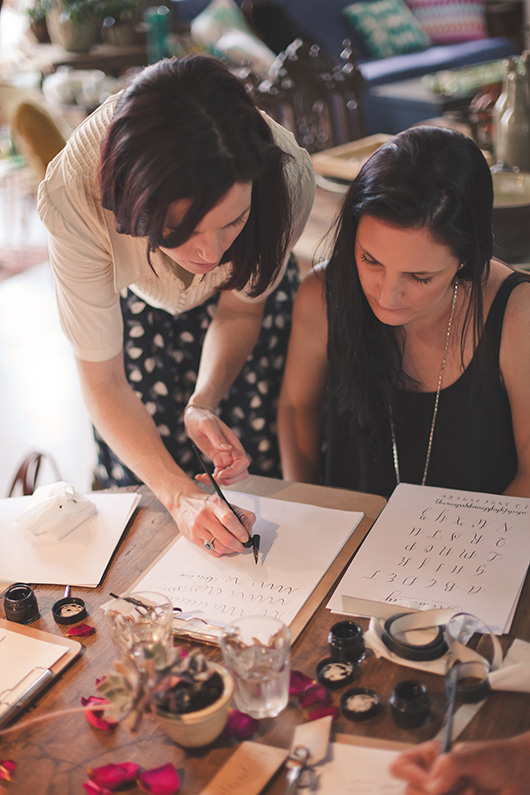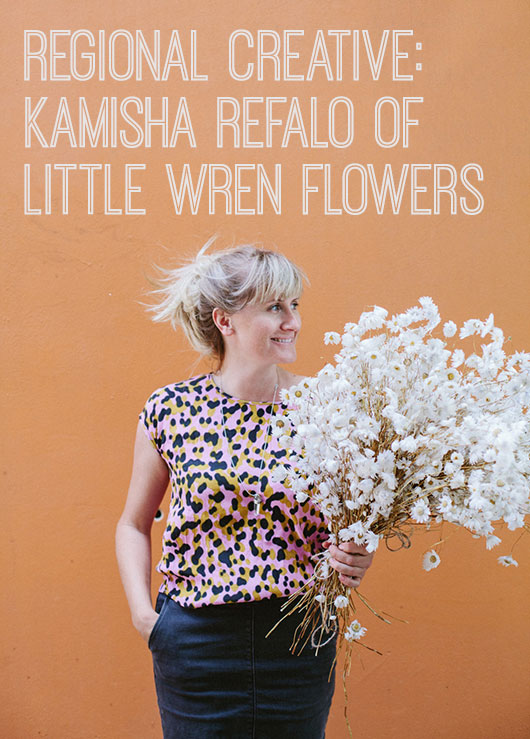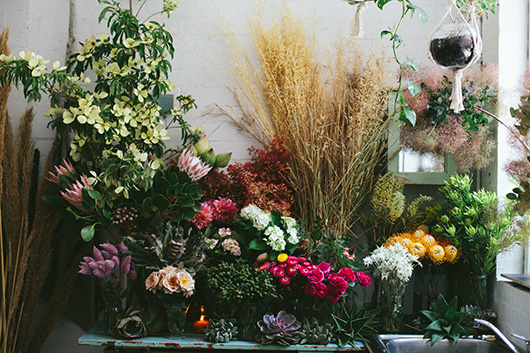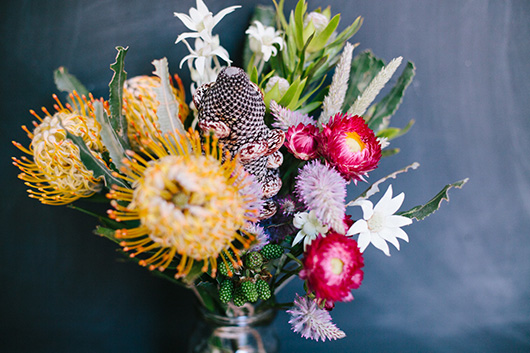Studio visit: Hayley Welsh, Street Artist
By Kristen Marano
Perth Street Artist Hayley Welsh works out of her home garage, but there’s nothing garage-like about it. Welsh has created a space that reflects every bit of who she is: a street artist, traveller, and family person.
Travel trinkets—mostly American flags from her school bus project —adorn shelves; colourful patterned rugs keep out the cold, and a refinished wood grain table lines the back of the room. Welsh has neatly organized a corner of paintbrushes and paints; vintage picture frames lay stacked on the floor, and the main garage wall is covered by floor to ceiling canvas and butcher paper for Welsh to sketch and paint on.
I met Welsh at her exhibition Hijacked, a collaboration with her partner and Photographer Andy Faraday. We recently caught up on a Friday afternoon to chat about her creative process, and how travel has influenced her work…
Describe the process of developing Hijacked and your choice of materials.
The whole thing was about seizing control of the situations that come to you and try to make the best out of things. It’s a belief that both Andy and I mirror in our work: try to seize what’s happening in your life.
I guess I looked at things I had been collecting, the ones that spoke to me that I could use to portray this ‘hijacked’ message. I had a collection of articles I was going to work on; Andy had been shooting his work in film and developing it. So, before the show we sat down, and I looked at works that Andy felt like that he would be happy for me to work on. I talked about pieces that I could see something happening. We wanted to create a show that we’d like to go see: sculpture, installation, a mixture of stuff and experiences. We tried not to make it a clinical and typical gallery space and more of an experience.
Describe the moment when you knew you wanted to create an exhibition about fear.
I was kind of dissecting what I was already creating. Figuring out what was I making, and what these creatures were. I realized it was all this recurring self-doubt.
When I held, Not You Again, which was a show about dealing with self-doubt, I read a book called, There’s Nothing Wrong With You. It was about how self-doubt and fear spreads to you from an early age. I thought it was interesting, and it explained a lot about why I feel the way I do. After reading that book I felt inspired that I wanted to explore that feeling.
How do you use this space to create?
I’ve been painting portraits a lot, and using this mirror to draw my reflection. My mood changes a lot in this space, and this wall can dictate the mood I’ve been in.
I don’t come into the studio until I’m ready to paint; I never enter the studio before lunch. It’s always messy before a show. Everything is pushed to the side, and everything I want to shoot is on the floor. “I’m always jumping from my computer to paint,” Welsh says with a laugh.
How has travel influenced your work?
Travelling is such a massive part of feeling empowered and meeting new people. I find you just get richer and richer in your experiences; you broaden your mind so much more. I can’t imagine my life without having travel being a big part of it. Travel has given me the kind of confidence to keep challenging myself, and keep stepping out of the comfort zone. We create better things when we are challenged.
That’s what I found with the school bus project a year ago. We had a show organized in New York, and we didn’t have the work for it. We decided to create the work while we were there. We bought a bus on the west coast, travelled to east coast, and I found whatever objects. I had a lot of self-doubt like what am I doing with my life? Why are we in a bus? But, I loved every second of it. All these emotions created that body of work.
What’s next?
Welsh had told me, “My dream would be a warehouse where I can relax, invoice, do admin stuff.” Maybe her dream is about to be fulfilled. Welsh and Faraday will soon host Not Another Open Studio, an invitation to join the duo in their new studio and see their new work in progress. Visit www.welshandfaraday.com to follow what they're creating.
{Title photograph by Kristen Marano}
Kristen Marano is a writer living in Perth, Australia. Kristen interviews women in business and writes about workplace culture. She contributes to Huffington Post Canada, and produces a weekly newsletter, Creative Women Weekly, featuring stories of creative women from around the world. Follow Kristen on Twitter @kmarano and Instagram @krismarano.
Studio visit: Reny Kestel, Milliner
Perth’s fashion scene continues to emerge, and Millinery Designer Reny Kestel is one of the city’s talented designers at the forefront of this movement.
Reny is a young and inventive hatmaker in a competitive industry that got its start in the 1800s. She designs and produces hundreds of headpieces a year for weddings, horse races and fashion weeks that range from edgy wearable art to classic and elegant hats, leather headbands and hand-beaded combs.
Reny, a Perth native, set up her studio and gallery two years ago in the city. Previously she was living in London, England, where she also discovered her interest in millinery.
Some might expect that attracting customers outside of Australia’s most isolated state might be difficult, but Reny’s future-thinking designs and respect for tradition keep her top of mind among a diverse customer base. Women rely on Reny to make custom hats for big racing events of the year like the Melbourne Cup and ongoing regional events throughout the country. She currently designs headpieces for Alana McLean, the face of WA Country Cups.
I visited Reny's Perth studio to ask her about her designs and learn how she stays relevant.
How did you get started in millinery?
I was going to Royal Ascot, and I must have spent hours in this small pokey shop looking at all the trimmings and hat blocks available. This exploring led me to inquire about millinery classes, and from there I have never looked back. I’ve fulfilled my vision by returning to Perth and launching my own label.
It’s kind of an ironic path as I’ve been fascinated with birds from a young age. In fact, I wanted to be an ornithologist when I was 12-years-old. So, it’s nice to be able to work with bird feathers.
 Reny Kestel works on a headpiece in her studio, one of hundreds she produces every year.
Reny Kestel works on a headpiece in her studio, one of hundreds she produces every year.
I have also always had a keen interest in art and design from a young age, and I continued this interest by studying Fashion Design at Central Institute of Technology in Perth. I love the idea of wearable art, and fashion is a great form of self-expression. The 3D shape in art and sculpture, and designing with patterns from flat fabrics has always been exciting.
How have you set up your space to help you be productive?
Being organised is definitely key. I need to have materials that I use frequently, easily accessible and colour coordinated so I can grab them with minimal fuse.
My other essential items are clearly positioned in the right workspace areas, such as millinery wire on hooks with tape measures and wire cutters hanging next to them. I have two large steel rulers fixed to the large central table, so when I need fabric straw materials or Petersham ribbon I can quickly measure the exact amount and be able to note the amount I use.
I always go by the rule that everything has a home. My materials are arranged and labeled so I know with a quick glance what I am looking for. I try to clear the workshop table space every few days or weekly, and put things back in their place after an artistic explosion. I find I can’t get into a creative mode and think clearly without using a clean space.
 Reny and her father created this thread spool holder to make her material easily accessible and keep it organised.
Reny and her father created this thread spool holder to make her material easily accessible and keep it organised.
What's your biggest creative fear and how are you overcoming it?
Not really fearful, but I’d call it…creative pressure – that is balancing my creative time with the general operations of the business, which involves emails, calls, sales, bookwork, administration, public relations and social media.
I also have to ensure that the time I spent creating each piece aligns with the price of the piece. This can create a bit of pressure to get things made within a certain time period.
 A leather headband in progress on Reny's work table.
A leather headband in progress on Reny's work table.
How does living in an isolated state help and/or challenge your business?
Since the whole Internet revolution, I don’t notice how isolated Perth is anymore. Connecting to people, finding inspiration, and material sourcing is not a problem now.
Perth’s population is small, so it does help in terms of networking. We are lucky to have a strong supportive fashion industry in Western Australia, and I think this is because the state is so isolated.
One last question…
At the end of our visit I asked Kestel if she has attracted any North American clients yet, where I anticipate her designs could catch on. “Not yet,” she said, but one thing is certain, Australia is lucky to have a defining homegrown designer like Kestel.
Follow Reny’s designs and shop online at www.renykestel.com.
{Studio images by Kristen Marano}
Kristen Marano is a writer living in Perth, Australia. Kristen helps companies build relationships with their audiences through compelling content programs. She also shares her fashion and lifestyle perspectives with Huffington Post Canada, and produces a weekly newsletter, Creative Women Weekly, featuring stories of creative women from around the world. Follow Kristen on Twitter @kmarano and Instagram @krismarano.
Regional Creative: Melanie Muddle of HoutenPlank
With so many of us are searching for that illusive work/life balance it’s refreshing to see someone who has been able to achieve that while creating a thriving small business from her passions. Based in Redhead, south of Newcastle, Melanie Muddle of HoutenPlank has managed to create an inspiring business that combines her love of food styling, woodwork and Dutch heritage while allowing her to spend precious time with her family. Here she shares an insight into her fledgling creative business and how she got to where she is today.
Tell us a bit about your background.
I’m a small town, big family kind of girl. My dad, a scientist come oyster farmer, moved the family from Sydney back to my mum’s hometown on the Tillegery Pennisular when I was young. I spent a lot of time outside, building bush cubbies, riding repurposed bikes from the dump, eating wholesome food and hanging out at the oyster block.
I’m a third generation ‘Dutchy’. My Oma and Opa came to Australia in 1952 and have been a big part of my life. It was my Opa who started the family oyster farming business and even in his nineties, he continues to demonstrate that working hard is in our genes. My family heritage is something I cherish and it was important for me to incorporate this into my business.
Inspired by a 1980’s food styling video at school, I decided I wanted to be a food stylist. After chatting to my science-loving dad, I shifted my focus to becoming a dietitian and took myself very seriously at uni. Soon after graduating I was surprised to find that typical dietetics wasn’t for me. I spent the next decade working in corporate dietetics, I enjoyed a stint in private practice, I met my husband at ‘The Worlds Biggest Disco’ and eventually returned to a management position in the Health and Wellbeing division of Sanitarium. And then came our babies.
What made you want to start your own business?
I loved my corporate job but motherhood has a way of changing your perspective (often without your permission). I tried to balance everything when baby Eve arrived, but it was impossible. I found myself without work and I knew that I had an opportunity to rethink and reshape my career, a moment to pause and contemplate.
Like many mums, I wanted to find the elusive balance between work, mothering and life in general. I wanted to do something was fulfilling and fun, that was aligned with my passions and that positioned me to continue to learn and grow.
How did you come up with the idea of HoutenPlanks?
I have always loved food. I think about it A LOT. I find food photography mesmerising and adore quiet time with food literature. I had watched that the ‘serving board’ trend become entrenched in food styling. I noted that recipe books, food magazines and cafes where using serving boards frequently. Food commentators were talking about the popularly of share-plates and the decline of entrée-main-dessert dining. Jamie Oliver centred his styling on painted serving boards and people couldn’t get enough of it. I knew that with time, the serving board trend would permeate households, generating demand for such products. I knew that ‘fashion for food’ was on the agenda and that HoutenPlank, which is Dutch for ‘wooden board’, could meet this growing market need.
How did you get started?
My husband Brad often scoffs at the depth of my research and detailed documentation. He’s a ‘get-in-there-and-get-stuff-done’ kind of guy. I’m the opposite and don’t mind generating a spreadsheet or trying to articular market insights. My second baby Esther arrived and I’d spend nights dreaming and working on my business plan. On weekends, in between breast-feeding, I’d slip down to the workshop to start prototyping. Brad was incredibly patient and supportive. He had a few doubts about my woodworking capabilities but nonetheless allowed me to use his tools. He always believed in what I was trying to achieve. He collected discarded workshop furniture from construction sites until we had built a functional little workshop. One sleep-deprived year later, I finally had a plan and the confidence to launch my business.
What are the pros and cons of running your own small business?
HoutenPlank provides me with a platform to do what I love. It seems that I’ve finally found my ‘groove’. After previously struggling with work-life balance, I’m happy to be able to control my workflow and how work impacts my family life (well, most of the time). More recently, I’ve relished the freedom to support my friends and family when they’ve needed it. I’ve enjoyed connecting, supporting and being inspired by local creatives. I’m also thrilled that spending hours on Pinterest and Instagram is now considered productive market research!
Business administration is my foe! Lauren Hung from The Black Line penned my new motto “face it or face-plant in it”. Bookwork, quoting and filing are not my favourite things but I’m learning how to effectively manage these tasks. I also find it difficult to manage growth with limited capabilities. There’s a constant re-evaluation of how to increase production without stepping outside my brand values. Growth is exciting, but also anxiety provoking. Most of the time I am ‘one-girl-in-my-garage’, both a pro and a con on many levels.
What has been your proudest achievement to date?
I wish I could tell you about my proudest achievement, but it’s still under wraps. What I can say is that I have won an unearthed competition and have developed a collaborative product, which will be available Australia-wide later in the year. This is groundbreaking for my business and I am preparing for a crazy, busy, exciting few months. I can’t wait until I can share more about it.
Has social media played an important part in growing your business? If so, how?
Social media has been an essential tool to create buzz about HoutenPlank. It’s been a cost effective way for me to increase brand awareness, encourage word of mouth, expand my reach, share my story, show my products, develop my style, engage in conversations and build relationships. I’m constantly amazed at the connections, opportunities and friendships that social media can forge. It’s a daily thing for me and I’m now at the stage of developing a social media strategy and calendar to help ensure it’s easy for me to reap the benefits of this medium.
What advice would you give someone thinking about starting their own creative business?
I’ve mentioned that I’m partial to research and planning. I believe that a well thought out business plan is an excellent launch pad for a creative business. I’ve recently looked back at my initial plan and while much of it now seems irrelevant, it was critical in the beginning. Don’t make the mistake of planning yourself in circles. There’s a time to plan and a time for action. A good business plan forces you to think differently, to stretch your ideas, to anticipate the challenges, to understand the market place, to be realistic in your financial forecast, but most of all it gives you confidence to take a chance to be successful at doing something that you love.
Now that I’ve rabbited on about planning, I’ll sum up a few other thoughts…be open-minded, invest in building relationships with stakeholders and customers, embrace collaborations, have a ‘roll-with-it’ attitude, don’t put all your eggs in one basket and never forget your raison d'être (reason for being).
On a quest to live a more creative life, Christina loves any type of crafty project and has tried everything from watercolours and flower arranging to paper craft and calligraphy. She has an unhealthy obsession with Instagram and when not working in freelance travel and lifestyle PR, spends her time as a mama, wannabe photographer and magazine junkie. She currently coordinates CWC events in Newcastle.
Interview: Roslyn Campbell of Tsuno
Sometimes a good road trip is all you need - this was certainly the case for TSUNO founder Roslyn Campbell. After studying industrial design, this self-described fiercely entrepreneurial lady had a great idea driving down the Hume highway one Christmas. But great ideas don’t just jump out from behind a road sign, and Tsuno was no exception; the synthesis of years of experience working odd jobs, discovering social enterprise and crowdfunding, and extensive travel in the third world, in particular becoming aware of barriers faced by women to attending school and work during their period.
Ros recalls arriving at her parent’s place on Christmas Day brimming with enthusiasm for sanitary products, much to the bewilderment of her family. In the year that followed that trip, Ros completed a small business course, designed and sourced a container load of sanitary pads and successfully launched Tsuno using Australian crowd funding platform Pozible.
Tsuno’s biodegradable sanitary pads are a functional, affordable, socially conscious, environmentally sustainable and beautifully designed solution to two problems - monthly sanitary protection and charitable giving. 50% of Tsuno’s profits are donated directly to programs that focus on empowering women, ranging from health initiatives, to education and small business. The first of these organisations to receive donations is the International Women’s Development Agency. To top it off, when placing you Tsuno order you also have the option of purchasing a box of pads for women supported by the Asylum Seeker Resource Centre here in Melbourne (surely one of the most worthy uses of a last minute ‘add to cart’ impulse!).
Getting to know Ros a little better over the last six months, it’s become evident that this self-made social entrepreneur is no accidental vocation, but the result of years of hard work and self-discovery. I asked her a little more about her business journey from the early beginnings to her current day-to-day...
Tell us more about why you chose to launch Tsuno via Pozible? Even before I had the idea for Tsuno, I was a big fan of crowd funding. It’s such a valuable tool for creative people to test an idea, kind of like market research, but in real time. Literally, asking the question 'would you buy this' ad then, 'if you would, please put your money where your mouth is', and if enough people do, then we're rolling!
Preparing for and running the campaign was a lot of work, but it was really the perfect fit for my goal to engage with my directly with my market. My target was definitely ambitious. Some of my friends tried to help by breaking it down to how much the campaign needed to make each day to reach goal. That freaked me out, because prior to that I was thinking a lot more abstractly, thinking that I only needed 2000 women to pledge $20 each, and how many menstruating women are there in Australia?! A lot! Having said that, I went through a time of extreme doubt, and found my best way to work through it was to ignore it. In the end the only reason TSUNO was possible is because of my friends. They started spreading the message.
The double edged sword of doing research [into launching a new product into the marketplace] is that you know you’re prepared, but you also know how advanced your competitors are. Luckily I eventually learnt to switch off to the 'comparison trap', recognising that it wasn’t helpful to the project or to my own self esteem. I learnt not to doubt myself, sometimes just through naivety. I think one of the strengths of not being an expert is that sense of flexibility in your approach, that you’re more willing to just try things out, take risks.
Towards the end of the campaign I had a great idea on how to engage my audience and pulled it together in a day. I like to think that that last push was the reason [the Pozible campaign was successful]. All the sudden pledges went from ten per day to one hundred. And it happened very quickly. It was awesome, but stressful at the same time. Possible sends you an email every time someone pledges, so my phone was vibrating like crazy for a couple of weeks!
What is the greatest thing you have learned in starting you own business? Learning how to ask for help. It’s something that’s definitely needs regular practice. The greatest challenge was getting to the point of asking; thankfully the Pozible model makes it really quite easy for people to get involved once you’re there. The ability to ask for help is something I’m motivated to improve on, and I’m definitely getting some positive reinforcement at the moment with the Sanitary Tax Petition campaign. This was only made possible because I asked for help and found someone keen to take responsibility for the project under my guidance, meaning they are enabled to spread the word without me micromanaging or spending hours creating content. She is so enthusiastic and excited and brings a great new energy to TSUNO, I think it has been rewarding for all.
What are you most looking forward to? Getting back into is product development. The first six months of TSUNO have been full pace: building the network, filling the Pozible pledges, getting the website up and running, moving warehouses too many times... meaning product development has really been on the backburner since launch. With an industrial design background, my mind is always thinking ahead in this area. Ultimately I want to build TSUNO into a brand that has every type of product that you might need during your period. I understand that some women don’t like certain products and others do, so I want to create a brand that caters for every woman's needs. My foremost interest is adding tampons to the product range, which is in the plan for the next year.
What is a typical day for TSUNO? (Laughs) I don’t have a typical day! A lot of it is battling with being self-employed, and trying to stay focused when my office is in my bedroom. I’m getting my head around it a bit more now, figuring out when I work well and when I don’t. One thing I’ve learnt is I have got to allow the morning to be slow, because I’m just not productive in the a.m. I get the same amount of work done in the afternoon as I would have in a whole day if I allow myself that time for slowness and gentle exercise in the morning. At the beginning I was just getting the basics done to make TSUNO possible, keeping everything very minimal. At the moment [I'm] putting processes in place to make things sustainable in the long run. The other thing that takes up a lot of my day is packing orders, which I would like to figure out how to be more efficient at. I spend a lot of time at the post office. I’m at the point now where I’m working out the best ways to do things, and generally trying to avoid moving warehouses every three months!
---
You can purchase TSUNO products from their website, and hey, consider adding one box to cart to be donated to a fellow lady in need! :)
{Images by Hania Glapa}
Keely Malady is a twenty-something year old graduate architect living in Melbourne. Keely’s blog, Small Talk & Co. Aims to hold a space open for a new conversation on the wonders of the small things that make up a life well lived. Find Keely on Twitter and Instagram @keelymalady or on Facebook /smalltalkco.
Interview: Louise Mulhall of Floralovely
Louise Mulhall is a Brisbane based Calligrapher and holder of possibly the most delightful business name I’ve yet encountered – Floralovely. With a background in floristry, it’s not surprising the find that Louise’s whimsical and fresh designs have attracted a strong Instagram and Facebook following, with demand growing for her pointed pen style.
Returning to an art practice that you had once been disappointed by is a courageous move - especially with a young family in tow. But Louise’s late night explorations in modern calligraphy have paid off handsomely, as her delightful creations are in demand for weddings, events and corporate clients. Louise also runs workshops across the east coast, to share her skills and passion with aspiring calligraphers.
Calligraphy is an ancient and evocative art practice, what initially attracted you to it? I initially became interested in calligraphy when I was in high school - I was always the girl at school with the highly decorated “title page” for assignments! For a short while I learnt broad nib calligraphy, but became disheartened when I wasn’t getting the results I wanted. So I put my tools away and didn’t give them another glance until many years later, where I discovered pointed pen calligraphy. This discovery of the tools which complimented my style unleashed my creativity and I fell completely in love.
Having worked in the wedding industry for many years, I could see there was a market for my own style of handwritten place cards and wedding invitations. I researched modern calligraphy online; bought all the recommended books I could find, did online courses and completed a modern calligraphy workshop in Sydney. I spent many, many hours at night once my daughter and subsequent son, were asleep refining my style and working my way through reams of practice paper and ink.
The name 'Floralovely' was intended to capture my love of both flowers and calligraphy, allowing flexibility between these two aspects of my business. Ultimately though, I decided to focus exclusively on my calligraphy business and put my Floristry career into hiatus.
What are the biggest misconceptions about your work?
If you were to look at my Instagram you might be lead to believe that my days are filled with playing with pretty papers and shiny inks when in actual fact my days are usually filled with taking my kids to swimming lessons or playing with play dough! Social media can be quite deceptive in that way.
As my children are still so young, I limit the amount of orders I take for calligraphy as my main job at the moment is Mum. I spend most days with my son and daughter and then work at night while they are asleep.
There’s a lot more involved with my business that just sitting down and writing for a couple of hours. I liaise with clients, order supplies, organise workshop venues and ticketing, create calligraphy drafts in pencil and I spend a lot of time practicing my lettering.
I definitely couldn’t keep working this hard if I didn’t love my job. I feel a great, personal fulfilment being able to write calligraphy for work and still be there for my kids when they need me.
My favourite quote at the moment is from Will Rogers (1879-1935) - “If you want to be successful, it’s just this simple. Know what you are doing. Love what you are doing. And believe in what you are doing.”
What have been your greatest challenges in starting your own business? I’ve found my greatest challenge is managing my time between work and family, which I’m sure is an experience shared with any working mother! Making the most of my child-free days is imperative, as well as a having a tolerance to late nights in the office. I try to stay out of my office on the days that my kids are home with me as I want to make sure my attention is on them and not on my work.
I have also found it challenging to keep on top of the administration work while still allowing myself plenty of writing and creative time. It’s easy to get caught up in emails and admin when you’re doing everything yourself but I need to make sure I have dedicated writing times where I don’t look at the computer.
What part of your day gives you the best 'flow' in your work? I really enjoy when I have a long list of names for a place card order or envelope addressing and I sit down with a cup of tea and just work my way through the list. It is so satisfying to see all the cards or envelopes lined up with the ink drying after I have finished them.
Talk us through a day in the life of Floralovely.
On the two days my children are in daycare/kindy, after the morning chaos and drop offs, I come home and settle into the stream of emails and admin work with a cup of tea.
Once I’m up to date, I’ll review the client brief and start warming up for writing. I’ve found I just can’t sit down and expect to start calligraphy work straight away. I I need to do a few pages of swirls, drills and practice alphabets to get going.
I’ll spend the rest of the day working through the order, whether it’s envelope addressing, place cards or a seating chart and before I know it, it’s time to pick up my littlies!
I mostly practice my calligraphy at night-time in the home office I share with my husband. In these quieter hours I have found the perfect environment that allows me to get my ink ‘flow’ happening. Everything is fairly still, my children are sleeping and I can really concentrate on what I’m doing.
----- Keely Malady is a twenty-something year old graduate architect living in Melbourne. Keely’s blog, Small Talk & Co. aims to hold a space open for a new conversation on the wonders of the small things that make up a life well lived.
Regional creative spotlight: Kamisha Refalo – Little Wren Flowers
Having recently made a sea change from the big smoke, I’ve noticed an abundance of local creatives doing incredible things across regional Australia, highlighting that you don’t need to live in a major city to fulfil your creative passion.
One such creative is Kamisha Refalo from Little Wren Flowers in Newcastle who is pushing the boundaries when it comes to creative floristry. Her bespoke work can be seen across retail outlets, cafes and magazines as well as weddings and special events. Here she shares some insights into running a small business and her creative inspirations.
Tell us a bit about your background? How did you get into floristry? I’ve been working in the floristry industry since I was 17 years old. My first job was at Roses Only in Chifley Plaza, Sydney. I felt like this would be the perfect ‘earthy’ job for a young country girl in the big city. I stayed there for a few years before moving back home to Bellingen on the north coast of NSW.
After that, I dabbled in the industry for a few years but never felt confident or ready to branch out on my own. It wasn’t until my partner and I travelled around Australia with our sons then 1 and 3, that I really gave some thought to starting my own business.
When we returned to Newcastle, I started Little Wren Flowers from home with just one client – Saluna Café – who I still work with today. From there, it grew really quickly and, with plenty of wedding requests and clients coming in, I moved into our studio on Darby Street.
What was the motivation behind starting Little Wren Flowers? Essentially it was to create something that could be flexible around my young children – at the moment I work part-time which I’m really grateful for. Rather than have a typical shopfront, my flower studio is by appointment only which means I can be more flexible with my hours. I never thought Little Wren Flowers would turn out to be as creatively rewarding as it is, which is great. I really love working for myself and am thankful that, at this stage, the business isn’t driven by money.
You have a really unique approach to floristry and a great eye for detail. Where do you get your inspiration from? I get my inspiration from the flowers. If you have fresh, beautiful blooms to work with, nothing can go wrong. I love natural, true-to-form arrangements – this style of floristry comes easily to me and I love that it resonates with so many people, too. In addition, living so close to the country, I am lucky enough to be able forage and handpick ingredients on a weekly basis.
How do you keep yourself creatively challenged working in a small regional business? I’m lucky that I have great clients who make me think outside the box each week. Creative collaborations are great, too, as they challenge what is possible. Social media keeps me on my toes and the changing seasons help as well, as I get to work with flowers and foliage that may often only be available for those few months each year.
What do you love most about running your own creative business? I love having flexible hours to suit my home life. I love the control and being able to drive Little Wren Flowers in the direction that is right for me. I also love the freedom to work at my own pace and indulge, at times, in creative ideas. Floristry is a very satisfying job – it’s about making clients smile using the beauty of a natural medium.
What are the challenges of running your own creative business? Like most creative people, I find bookwork and quoting on jobs can be challenging – I try very hard to please everyone! The other big challenge is to not take on too many overheads. I don’t want money to be the sole motivation of the business. At present, we only buy for clients so there is very minimal waste or loss.
I also currently have three amazing casual staff at Little Wren Flowers and we all work really well together. As the boss, I am always learning how to make my team more comfortable and happy after each big project. My aim is for my staff to genuinely love what we do and never feel like it is just a job for them.
Do you find there are any differences between working in a regional area compared to a big city? For sure! Everyone is so supportive in Newcastle and I get such great positive feedback from the locals. I couldn't imagine living in a big city, let alone operating a small business there! We have it made in Newcastle - everything is close enough that it’s rarely stressful. The furthest we ever travel is an hour-and-a-half to the Hunter Valley to set up weddings. Unfortunately the drive to the Sydney Flower Markets is a mission from Newcastle. I would love for the Sydney Flower market to be more accessible.
Is there are a strong creative community in Newcastle? Does this help with your creativity? Yes, the creative community here is very strong and inspiring. I collaborate regularly with a number of different people and am grateful for each and every opportunity. I just wish I had more time! There are so many awesome creative projects, openings and markets happening in Newcastle every day.
What does a typical day at work look like for you? I have three types of days. A typical market day sees me wake at 2:30am and drive to the Sydney Flower Markets. It’s a 2.5 hour drive each way, so I usually get back to the studio around 9:30am and unload all the flowers and group them according to events, weddings and our weekly clients. If there’s time, I head home for a nanna nap, then pick up the kids from school at 2:45pm.
A typical creative day in the studio making up wedding flowers often means I work back until 9/10pm, just to make sure everything is perfect. A wedding delivery and set up day starts at 5-6am to dress all bridal flowers, make any delicate crowns or hair flowers then pack the flowers into cars and head out to the wedding venue, usually by 2pm.
A typical studio day starts by getting everyone to school then heading into the studio by 9am to check emails. I then create any orders and weekly clients orders, deliver those then pick up the kids and head home, or stay back late and get on top of quoting and paperwork.
I love the variety of my days, so I guess there is no typical day other wise this job/career would not suit me. I love the ups and downs and the many different briefs and ideas that get thrown my way.
What are your big plans for 2015? To move to a larger studio and buy a cool room – which would be heaven. I also have some creative weddings booked which I am really looking forward to getting my hands dirty for this year. And I would love to grow more flowers!
{Photos by Hannah Robinson}
Having swapped the big smoke for coastal life, Christina Atherton is on a quest to live a more creative life and shine the spotlight on regional creatives. She has an unhealthy obsession with Instagram and loves any type of creative project having tried everything from watercolours and flower arranging to paper craft and calligraphy. When not working in PR, she spends her time as a mama, wannabe photographer and coffee addict. Christina is also the CWC Event Host in Newcastle, NSW.
Interview – Tess McCabe of CWC and Creative Minds Publishing
 By Andrea McArthur
By Andrea McArthur
Tess McCabe is a Brisbane-born, Melbourne based creative entrepreneur who has made Creative Women's Circle (CWC) the inspirational community that it is. Recently, Tess has also founded a resource for smart working creatives called Creative Minds Publishing. A big thanks to Tess for sharing her thoughts with us.
Can you give a brief description of your path to CWC and Creative Minds Publishing.
From an early age I’ve been a lover of printed things – books, magazines, posters, stationery – though it wasn’t until late high school that I could ‘name’ graphic design as the career path to follow. At that point I was pretty determined to make that happen, though I was also open to whatever opportunities came my way job-wise in the industry. So after a Bachelor of Design Studies at Griffith University in Brisbane, I worked for a big publishing house designing educational and non-fiction books. I also freelanced for small studios and my own clients creating brand identities, printed things and web stuff, and after a year of travel found myself working independently full-time in 2008 doing all of the above. As a ‘side project’ and as a way to meet people in my new home town of Melbourne, I took over coordinating CWC in 2009 from its founder Dearne Mills.
CWC grew in hops, skips and jumps, and in 2011 I was looking for a project that could combine my love of print and my interest in the stories of other creative women. I’m really passionate about promoting the work of women in creative industries and shining a spotlight on their career achievements. Thus Conversations with Creative Women was born, which seemed like a natural progression for CWC. That really sparked my interest and zest for self-publishing, so Volume Two appeared two years later.
I’m a keen observer and listener, and if I think that there is a need for a particular resource for the community of independent creatives I am so invested in to be realised, then I think of ways to make it happen. The launch of Creative Minds Publishing earlier this year is basically a way to put an umbrella over these ideas.

Describe CWC's core values?
We value shining a spotlight on the creative work of women, because we feel that women are vastly under-represented on many platforms that promote the work of creatives. But we also value sharing and uncovering the truth that there are many varied paths a creative career can take, not all of them conventional and most of them incorporating all of the other messy life stuff that comes with being a creative lady e.g. making money; having a family etc.
At what period did you feel CWC gaining momentum?
Probably after the release of Conversations with Creative Women: Volume One, and the introduction of memberships and The Circle Database in 2012. Those things extended the reach of CWC and meant connections between creative women from all walks reached beyond Melbourne’s borders (which at the time was the only place we held our in-person events).
Where would you like to take CWC in the future?
To be honest, 2015 could be a fairly significant year for CWC!
Event-wise, in 2014 we’ve had speaker events and Member’s Morning Teas in Sydney, Newcastle, Brisbane and of course Melbourne, and next year I’d love to see these events being hosted in the other capital cities and major regional centres as well.
As The Circle Database grows, it will be great to see more interaction between Members and more of their needs addressed through website upgrades and additions.
Structurally however, there are some changes which I’m hoping to make that mean the community of Members we’ve built will get to take a lot more ownership over the future direction of CWC. This is all in the planning stages at the moment, but more than it being an exciting thing for the group, it’s the right thing to do for the future of CWC and its sustainability as well. Stay tuned!

What is the next event that CWC is hosting?
We’ve just had our last speaker and morning tea events in Brisbane, Melbourne, Newcastle and Sydney for the year over the last few weeks. Now it’s time for some resting, recharging, plotting and planning before we get back into the swing of things in February/March next year.
How has networking helped you so far?
I’m not a native Melburnian, so when I moved here 8 years ago I didn’t know very many people. Plus, 12 months after settling here I decided to become self-employed and work from home, which wasn’t a great strategy for meeting new people! Networks like CWC helped me get the support I needed as an independent business woman but has also gained me some very dear friends along the way. I’m a pretty introverted person by nature, and traditional networking doesn’t gel with me, so I really built CWC up to be exactly the kind of non-threatening networking device I wanted (and that I could see other people liked as well!). Yes I have gained a few clients through it, but mostly it’s given me a cushion of support and many, many bursts of inspiration as I fumble through my own business ventures.
Has social media played a large factor in your businesses success as well?
Definitely. When I took over CWC in 2009, blogs were becoming popular but the other platforms we are so accustomed to now either didn’t exist, or weren’t as widely used yet. The introduction of Facebook, Instagram and Twitter and the ability for the CWC community to meet in person at events and then stay connected through those channels has been imperative to CWC’s success – they work hand in hand. Though if we could all agree to hold off introducing another social media platform for a while that would be great – it’s a lot to keep up with!
Have any of your creative businesses been a product of personal projects coming to life?
I suppose Creative Women’s Circle evolved from a side project into something I spend a lot more time on and take more seriously from a business perspective. I’ve learned to keep truly personal and fun projects out of the business sphere as much as possible, to that the pressure off and to ensure they stay fun.
Have you always had your “Creative Minds Publishing” idea in the back of your mind?
Having my own publishing company was not something I always intended to do. I tend to focus on 3-5 year goals, so professionally I know what I am working toward, but those goals are always somewhat vague (or have ‘feathered edges’ as I like to think). I have a very young family and my partner is also self-employed, and so professional goals at this stage of my life have to be fluid and flexible. I would go so far to say as I will probably always want to work in graphic design, in print, and spearhead my own projects with cool people, so that combination of things is what spurned Creative Minds Publishing. But I have no master plan for the brand just yet – I’d like to see it develop on its own first and then mould it from there.

When did you decide to act?
At the beginning of 2013, CWC held a speaker event with Melbourne intellectual property lawyer Sharon Givoni about protecting copyright for creatives. It was one of our most popular events to date, and afterwards over coffee Sharon and I mused that there wasn’t a single comprehensive resource available to creatives that explained the concepts she discussed in the workshop, and the issues her clients come to her with every day. With her interest in writing and mine in publishing, and our combined networks of creatives from which to draw inspiration and target the resource, it seemed like a natural next step to produce a book together: Owning It: A Creative's Guide to Copyright, Contracts and the Law. Formalising an imprint under which to release the book in 2015 was the impetus for launch Creative Minds in August this year. Plus, it made sense to re-release my earlier eBook Graphic Design Speak in print (yay!) to welcome the brand to the world!
Over the years how have you learnt your main business lessons. From trial and error, reading, workshops or bringing specialists in?
Probably the biggest lesson is to listen to the advice and feedback of others, but know when to take that advice with a grain of salt, and also know how to vet those to ensure they have your best interests at heart. In the past I have screwed myself over by not trusting people enough, and been screwed by trusting people too much. It’s tough steering a ship whilst also drawing the map – you need people around you but it can take time to find the right support network.
I read a lot, but not the kind of ‘business’ books you might think. I like memoirs, particularly comedian’s memoirs. Comedians are self-employed, creative, pursue a niche industry they are intensely passionate in - often for years before they find success - but at the same time they are acutely aware of the absurdity of life and how lucky they are to be able to do what they do for money. I like that attitude.
Many of the little nuggets of advice that rattle around my head are from CWC speakers, or interviews on our blog or the Conversations books. I feel pretty lucky to have that constant injection of real-life advice from other women who are steering their ships in the same ocean as me!

And, what advice has stayed with you.
I’m not sure if there is one specific piece of advice that is high above all the rest, but we all know that saying ‘no-one on their death bed ever wished they had spent more time at the office’. So probably the advice I try to keep front of mind these days is to work when it’s work time, enjoy family time when it’s family time, and relax when it’s relax time (and have a decent measure of all three in an average week!). That doesn’t always go to plan (I can’t help it if I come up with a great work-related idea when I am playing with trucks with my son!) but it’s important to keep trying.
Walk us through a day in the life of Tess.
I’m working full-time hours at the moment while my husband does the stay-at-home-Dad thing, something we consider ourselves pretty fortunate to be able to swing. So my day starts when my son, who is two-and-a-half, wakes up around 7am. From there all three of us amble around trying to get fed and dressed in a reasonable amount of time. I leave the house around 8am and walk to my office in a shared studio space five minutes away. Once there, I tackle the to-do list that I have made the previous day, usually starting with emails that have come in overnight. On an average day I will do a couple of hours of graphic design work for clients (while listening to my favourite podcasts), a couple of hours of work on Owning It or another smaller publishing project, and some time on CWC (preparing a blog post, emailing with a speaker or event host, tinkering with the website, or sending out book orders or membership packs). I’m pretty head-down-bum-up productive – way more so than when I didn’t have a kid and didn’t have to shut down my computer on the dot of 5.30pm. When I leave the office I head straight home to hang with my family and catch up on the day, wrangle the kid into a bath and then into bed, and then have dinner with my husband. After dinner I might do a gym class (no more than twice a week though... I hate exercising but have come to recognise it’s a necessary evil!), or record an episode of The New Normal Podcast with my friend and neighbour Emma Clark. Weekends are family time and I’m pleased to say I’ve stopped doing computer work on weekends – there’s just no time (or energy) after toddler taming and it’s nice to return fresh after a break from the big screen on Monday morning. I still check email and social media on my phone pretty regularly though... can’t break that addiction unfortunately.
What were you doing the last time you looked at a clock and realised you had lost all track of time?
Sadly it was probably tackling a rather unwieldy email inbox or getting stuck on a design. How I DO like to lose track of time is painting, or reading, or meals with family and friends.
- - -
You can become a member of Creative Women's Circle or view the titles under Creative Minds Publishing.
Andrea McArthur (www.andyjane.com) has a passion for all things visual and works as a Senior Graphic Designer in Dubai. Type is her true love and goes weak at the knees over beautiful design. You’ll find her sharing image musings on Instagram @andyjanemc.


